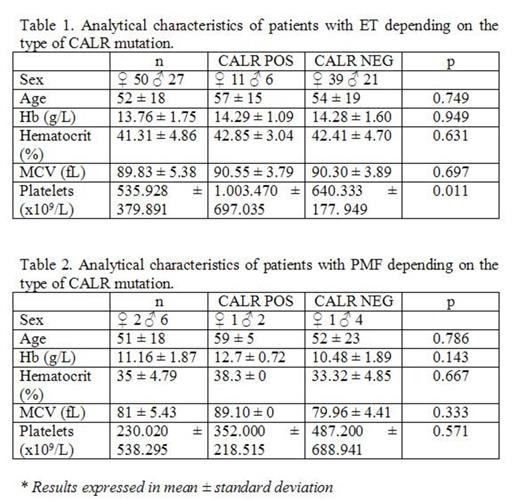Abstract
Introduction: Calreticulin (CALR) is a multifunctional protein regulated by calcium that is located in the endoplasmic reticulum. Recently, mutations in the calreticulin gene have been described in patients with the diagnosis of essential thrombocytemia (ET) and primary myelofibrosis (PMF), mainly in JAK2-negative cases. CALR mutations are localized to exon 9 and generate deletions or insertions that lead to a frameshift change resulting in a mutant protein. The detection of these mutations helps in the actual diagnosis of JAK2 mieloproliferative syndromes (MPN). Our aim is to assess the utility of the determination of these mutations in the management of patients with diagnosis of MPN in our center.
Patients and methods: This study includes 94 patients with diagnosis of JAK2-negative MPN retrospectively selected following clinical and analytical criteria between 2008 and 2014 in our center (Table 1, 2). CALR mutations were performed with the use of fluorescent PCR following the methods described by Klampf et al. (NEJM, 2013).
Results: 94 patients were analyzed, 77 of them had the diagnosis of TE, 8 of PMF and 9 of others disorders of myelodisplastic/mieloproliferative. 22% of the cases of ET had mutations in CALR (Table 1). In these mutations, a total of 53% were type I mutations (52-bp deletion) and 47% were type II mutations (5-bp insertion). Only one mutation was infrequent, a 46-pb deletion. We have found statistical correlation in the number of platelets depending on the presence of the mutation and in the largest number of platelets in type II mutations. 33% of the cases of PMF had mutations in CALR, all of them type I. Among other diseases not included in MPN, one of them had a type I mutation (data not shown).
Conclusions: Our results are close to recently published results regarding the frequency of mutation and as the largest number of platelets in type II mutations with respect to mutation type I. This study confirms the importance of CALR mutations determination in the diagnosis of JAK2-negative ET and PMF with high clinical suspicion.
No relevant conflicts of interest to declare.
Author notes
Asterisk with author names denotes non-ASH members.


This feature is available to Subscribers Only
Sign In or Create an Account Close Modal